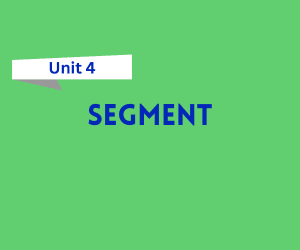
Free Download Segment Notes in pdf – Bca 6th Semester. High quality, well-structured and Standard Notes that are easy to remember.
Click on the Download Button 👇
Segment in Computer Graphics
A segment in computer graphics typically refers to a straight line or a portion of a line that connects two distinct points in space. In more advanced contexts, “segment” may also refer to a part of an object or an entity that is being processed or displayed in graphics systems. In the context of computer graphics, segments are often used as the building blocks for more complex shapes, structures, and scenes.
Key Points about Segments
Definition:
- A segment is a straight line that connects two distinct points (called endpoints) in a 2D or 3D space.
Components:
- Endpoints: The two points that define the start and end of the segment.
- Length: The distance between the two endpoints.
- Direction: The straight path from one endpoint to the other.
Applications:
- Segments are used to form polygons, lines in graphs, boundaries, and 3D objects.
- In digital image processing, segments are used to represent boundaries of objects within an image.
Types:
- 2D Segment: A segment in a two-dimensional plane.
- 3D Segment: A segment in three-dimensional space, with direction and length.
Features of Segments
Basic Geometric Structure: Segments are defined by two points and have a straight-line nature. They have a defined start and end.
Mathematical Representation: In computational geometry, segments are often represented mathematically by their endpoints, making it easy to compute lengths, intersections, and angles.
Vector Representation: A segment can be represented as a vector, which helps in calculations involving directions and scaling.
Building Blocks: Segments serve as the foundational elements for constructing more complex shapes like polygons, lines, and meshes in both 2D and 3D graphics.
Efficient for Algorithms: Since segments are simple, they are used in various computational geometry algorithms such as collision detection, pathfinding, and rendering.
FAQs on Segments in Computer Graphics
Q1: What is a segment in computer graphics?
A segment is a straight line defined by two distinct points, called endpoints. It is the simplest geometric entity used in computer graphics.
Q2: How is a segment different from a line?
A line extends infinitely in both directions, while a segment has defined start and end points, making it finite.
Q3: What is the purpose of using segments in graphics?
Segments are used to form the edges of polygons, paths in vector graphics, and boundaries in 3D modeling and rendering. They are essential building blocks in visual design and computational geometry.
Q4: How are segments represented in a graphics system?
Segments are typically represented by their endpoints in a coordinate system (e.g., (x1, y1) and (x2, y2) for a 2D segment).
Q5: Can segments be used for rendering complex shapes?
Yes, segments are used as the edges of polygons and other complex shapes. By connecting multiple segments, designers can create intricate shapes and structures in 2D and 3D graphics.
Q6: What are some applications of segments in computer graphics?
- Polygonal meshes: Segments are the edges of polygons in 3D modeling.
- Collision detection: Segments help in checking if objects intersect.
- Pathfinding: Segments are used in algorithms to find the shortest path between points in games or simulations.
Q7: How is the length of a segment calculated?
The length of a segment can be calculated using the distance formula in 2D or 3D space. In 2D, the length of a segment between two points (x1, y1) and (x2, y2) is:
Length=(x2−x1)2+(y2−y1)2
In 3D, the formula also includes the z-coordinate: